2020 Indian Challenger Review – First Ride
Is it the Ultimate American Bagger?
What exactly the hell is the meaning of this, letting a 30-year old kid be the Powertrain Project Engineer for an all-new bagger? What could a callow youth who roadraces a 15-year old GSX-R600 and rides a Tuono on the street, possibly know about the bagger mentality? When they’re not tearing around on sportbikes (and Indians!) because the snow’s too deep up in Minnesota, that 30-year old engineer (who only spoke to us on condition of anonymity) and Product Director Josh Katt are plotting mostly legal routes to get to work on Polaris snowmobiles. If that’s not heretical enough, Indian put a Swedish guy who designed BMW motorcycles for 15 years in charge of design – Ola Stenegard.
2020 Indian Challenger
| Engine | 19.0/20 |
| Suspension/Handling | 12.5/15 |
| Transmission/Clutch | 8.5/10 |
| Brakes | 8.5/10 |
| Instruments/Controls | 4.5/5 |
| Ergonomics/Comfort | 9.5/10 |
| Appearance/Quality | 9.0/10 |
| Desirability | 9.0/10 |
| Value | 8.5/10 |
| Overall Score | 89/100 |
The culmination of all that – I think it was the young engineer who said it – is “the first bagger that’s fun to ride.” I don’t know if I can go quite that far, but the all-new 2020 Indian Challenger really is a big step funward in the big bagger category. All the Indian guys on the project (the ones I asked anyway) are as big fans of the BMW K1600B bagger that won MO’s last bagger comparison as I am, but they also freely admit the German bike wasn’t their primary target when they built this one: The Challenger’s aimed squarely at the biggest-selling big bike in America, the H-D Road Glide. Or is it the Street Glide? You get the picture. Heck, they even brought an RG along on the launch for us to ride and compare.
The Challenger takes up the challenge with an all-new liquid-cooled “PowerPlus” engine that does a pretty good job disguising its liquidity, for people for whom that’s still important; no unsightly hoses to be seen, and the radiator is unobtrusive enough. Greater cooling capacity lets everything be tightened up, including compression ratio – now up to 11:1. That’s the same CR as the 116-inch air-cooled V-twin in the latest Chieftains, but instead of that engine’s old-timey 103.2mm x 113mm bore and stroke, the Challenger goes all modern oversquare, with 108 x 96.5mm dimensions. Instead of the air-cooled engine’s claimed 126 pound-feet of torque at 2900 rpm, Indian says the Challenger’s producing 128 lb-ft at 3800 rpm. Critically, instead of just not mentioning horsepower (ala Harley-Davidson’s longstanding practice), Indian’s proud to announce the new liquid-cooled 108 makes 122 horses at 5500 rpm.
My in-house rectal dyno puts it at about 110 rear-wheel Dynojet horsepower, which is a giant step up from the typical big twin’s 80 or so, south of 5000 rpm, and if you want to push the Challenger’s tachometer needle into the red, all the way to 6500, nothing’s preventing you. In spite of that higher revvability, the new motor’s happy to burble you smoothly along below 2000 rpm all day in relaxed-cruising mode, or effortlessly along the freeway at 80 mph and 3200 rpm. The difference is, when you want to go a little faster, a slight movement of the right wrist has you at 100 just as effortlessly. Matter of fact, 120 comes up pretty dang fast, too. I never quite had enough road to find out where it all ends.
Normally you wouldn’t take the motorcycle press up Nacimiento-Ferguson Road on your new bagger, which drains crazily to the Pacific from the coastal mountains south of Monterey, but Indian felt like it was the right thing to do. As it turns out, the Challenger tackled those convoluted miles of second-gear switchbacks and dirty twists and turns as enthusiastically as the world’s biggest supermoto might have, the main diff being you don’t have to stick out your feet because the floorboards already have them there.
Exiting those tight corners gave the new 108 a chance to really shine. The Dark Horse and Limited models also got the now de rigeuer 6-axis IMU. You could feel the rear Metzeler spin about a third of a rotation heeled over on its edge as you’d give it an injudicious handful of gas, and then the lean-sensitive traction control would step in for just a split second, and off you’d roar to the next corner. About 3000 to 5000 rpm is the new engine’s real happy place, and I swear I think it lifted the front wheel a couple of times out of those tight corners.
Salvo Pennisi, star of Mark Miller’s Sicilian vacation and a head of development at Pirelli/Metzeler, was in my mirrors the whole way. Later, he confessed he was having a blast on the Challenger, and kept thinking to himself “I’m doing something really stupid” every time he cranked the throttle to the stop, but kept doing it anyway. The Challenger’s “Smart Lean Technology” always has your back. Pennisi was along for the ride because Metzeler built custom Cruisetec tires for the bike – a kind of hybrid, reinforced sport-touring tire of the kind the company more commonly produces for BMW and other high-horsepower sport-tourers, but also designed to deal with this big V-Twin’s instant low-rpm torque and weight. (Salvo says the new tires are fantastic in the wet, too – but then he is a paid spokesperson.)
When we first clapped eyes on the new bike, in Carey Hart’s large garage, I thought it was a smaller and lighter thing than the Indian Chieftain I’d got to the central California coast upon earlier in the day. Alas, that’s more an optical illusion brought about by Ola Stenegard’s crisp styling: A look at the spec charts later reveals identical rake/trail and wheelbase numbers between Chieftain and Challenger, and a claimed dry weight of 805 pounds for the Challenger – 7 pounds more than the current Chieftain Dark Horse. I suppose it is like Reid Douglas the PR guy points out: Nobody in bagger land really asks for lighter/smaller.
Well. On the road, on twisty roads especially, I never would’ve guessed the Challenger’s heavier. The specs also contend that the Challenger has about ⅓-inch more ground clearance than the Chieftain, and a seat that’s nearly a full inch higher (still low at 26.5). I suspect raising the whole bike that much, combined with Salvo’s custom Metzeler Cruisetecs, is what gives it a considerably more agile feel than the Chieftain: That and the more sprightly feel a big dose of horsepower gives any vehicle. The extra height also gives the Challenger serious cornering clearance; you’re motoring pretty smartly along before the floorboards touch down.
Here’s to Indian for taking us on a decidedly “sporty” route on the new bike. I jacked a bit of rear preload into mine to get it to carve a bit sharper. Stiffer fork springs wouldn’t have been bad, and with all that power shoving the 800-pound gorilla into those tight corners, the front Brembos felt a bit marginal. But for 98% of the riding most of these bikes will be doing, those things won’t be a problem; mashing the rear brake is way more effective on a big bike like this than on some mincing little sportbike. You also just really can’t complain about the suspension’s very nice bump compliance for normal baggering around.
On the straight and narrow, even though the new engine’s turning about 3200 rpm at 80 mph to the Chieftain’s 3000, the Challenger runs smoother and freer, and sorts through its six gears easier, with a nice slip/assist clutch.
The ergonomics between the two are nearly identical, but the seat on the Challenger moved rearward about an inch to provide more room – which taller people will dig, but moved the handlebar a smidge too far forward for my 5’8” bod. Not a dealbreaker by any means, thanks to standard cruise control. Notable by its absence are standard heated grips. WTF?
Then you’ve got your all-new wind-tunnel sculpted frame-mounted fairing complete with electric up-and-down windshield, and behind it I found much happiness and serenity with the shield adjusted to just below my line of sight.
The weather never really heated up on my two days on the bike, but even stopped in traffic I never felt much heat wafting up from the big engine at all. You can’t really sense that the automatic rear-cylinder deactivation has killed the spark except for the little icon on the dash that lights up to tell you the rear heat source is now acting as a 54-cubic inch cool air pump.
At the end of the day, two days really, I do have to agree that this new Indian really does ratchet up the fun quotient. There’s nothing terribly original about giving a thing a bunch more horsepower, but until now nobody else in this category bothered (except BMW, but that’s an inline Six and kind of an apple among oranges). Why not?
Torque is good and has traditionally been the main ingredient when baking a bagger. But any self-respecting hot rodder can tell you that’s only half the equation; rpm and horsepower are equally important, and as Kevin Cameron pointed out elsewhere, the bore and stroke of the new Challenger engine are almost identical to the inimitable 427 Chevrolet big block of yore. The roller-rocker/hydraulic lifter tech that makes those rpm possible isn’t much more cutting edge than a big block Chevy, but it still works fine and means no more valve adjustments. It’s probably not a coincidence that riding the Challenger puts one in the same slightly antisocial but uplifting frame of mind as peeling out in one’s Chevelle past the high school parking lot (it’s easy to turn off the TC with a gloved finger). Not that that’s modern, but baggers are also about appealing to nostalgia. Not that this bagger necessarily is, since Indian says its audience is younger and hipper, just like the people who design and build them. Which is also not a coincidence.
Speaking of modern, whenever something’s new in the world of motorcycles, there are always at least a couple people in the crowd who hate it; looks are probably a thing the people who greenlighted the Victory Vision are still more keenly aware of than most. I didn’t hear anybody knock the looks of the Challenger at all, which walks that line between traditional and modern pretty nicely. Everybody seems to be a fan.
At the risk of sounding like I’m on the Indian payroll lately, what with first the FTR1200 a few months ago and now this thing, I’m going to have to say I think they knocked it out of the park again. The Indian wars are well and truly on again, the Germans are about to enter the fight too – and it’s beginning to be a helluva lot of fun to be a “cruiser” guy.
2020 Indian Challenger
+ Highs
- 122 horsepower @ 5500 rpm
- Serene cockpit with big Infotainment
- A truly “fun-to-ride” bagger as advertised
– Sighs
- I can’t believe heated grips are optional
- We gained more than a few pounds
- When will there be a self-riding option so I can watch videos?
In Gear

Helmet: [url=https://imp.i104546.net/c/404739/1147743/11256?subId1=VS_motorcycle_Revzilla_2020IndianChallengerReview&u=https%3A%2F%2Fwww.revzilla.com%2Fsearch%3F_utf8%3D%25E2%259C%2593%26query%3DShoei%2BNeotec%2B2%2BSplicer]Shoei Neotec 2 Splicer[/url][/b] $799[/p]
- Jacket: [url=https://vansonleathers.com/mens-collection-of-motorcycle-jackets-racing-suits-pants-chaps-more/39-model-AR-rayon-firenze-leather-motorcycle-jacket-AR2.html]Vanson AR3[/url] $562.50[/b]
- Gloves: [/b] [url=https://imp.i104546.net/c/404739/1147743/11256?subId1=VS_motorcycle_Revzilla_2020IndianChallengerReview&u=https%3A%2F%2Fwww.revzilla.com%2Fmotorcycle%2Freax-superfly-mesh-gloves]Reax Superfly Mesh[/b][/url] $69
- Jeans: [url=https://www.motonation.com/store/pc/viewPrd.asp?idproduct=7828&idcategory=196]Trilobite Parado Elastic Men’s Jeans[/url][/b] $219
Boots: [url=https://www.motonation.com/store/pc/viewPrd.asp?idproduct=5944&idcategory=6]Sidi Arcadia Tex[/url][/b] $179[/b][/p]
2020 Indian Challenger Specifications | |
|---|---|
| Colors/MSRP | Challenger:Titanium Metallic – $21,999 Challenger Dark Horse: Thunder Black Smoke- $27,249Sandstone Smoke – $28,249White Smoke – $28,249Challenger Limited: Thunder Black Pearl – $27,999Deepwater Metallic – $28,749Ruby Metallic – $28,749 |
| Engine Type | Liquid-Cooled SOHC 60˚ V-Twin; 4 valves/cylinder |
| Transmission | 6-speed/constant mesh |
| Battery | 12 volts / 18 amp/hour, 310 CCA |
| Bore x Stroke | 4.252 in x 3.799 in (108 mm x 96.5 mm) |
| Displacement | 108 cu in / 1768 cc |
| Compression Ratio | 11.0:1 |
| Clutch | Wet, multi-plate with assist |
| Exhaust | Split dual exhaust with resonator |
| Final Drive | Belt drive, 152 tooth |
| Fuel System | Electronic fuel injection, closed loop/52 mm dual bore |
| Charging System | 55 amp max output |
| Oil Capacity | 5 quarts (4.73 liters) |
| Fuel Capacity | 6 gallons (22.7 liters) |
| Primary Drive | Gear drive wet clutch |
| Torque | 128 ft-lbs at 3800 rpm, claimed |
| Horsepower | 122 hp, claimed |
| Front Suspension | Inverted telescopic fork, 43 mm diameter, 5.1 in (130 mm) travel |
| Rear Suspension | Single shock 4.5 in (114 mm) travel, hydraulic adjustable |
| Front Brake | Dual 320 mm floating rotors with 4-piston calipers, ABS |
| Rear Brake | Single 298 mm floating rotor with 2-piston caliper, ABS |
| Front Tire | Metzeler Cruisetec, 130/60B19 66H |
| Rear Wheel | Cast 16″ x 5.0″ with tire pressure monitoring |
| Front Wheel | Cast 19″ x 3.5″ with tire pressure monitoring |
| Rear Tire | Metzeler Cruisetec, 180/60R16 80H |
| Dry Weight | Challenger: 796 lbs (361 kg), claimed Challenger Dark Horse: 796 lbs (361 kg), claimed Challenger Limited: 805 lbs (361 kg), claimed |
| Ground Clearance | 5.4 in (137 mm) |
| GVWR | 1,385 lbs (628 kg) |
| Length | 98.5 in (2501 mm) |
| Rake/Trail | 25° / 5.9 in (150 mm) |
| Seat Height | 26.5 in (672 mm) |
| Wheelbase | 65.7 in (1668 mm) |
| Infotainment | Challenger: 7-inch screen, 100-watt audio with AM/FM, Bluetooth and USB Challenger Dark Horse and Challenger Limited: 7-inch screen, 100-watt audio with AM/FM, Bluetooth and USB, GPS navigation, traffic/weather overlays, customizable route builder |
More by John Burns





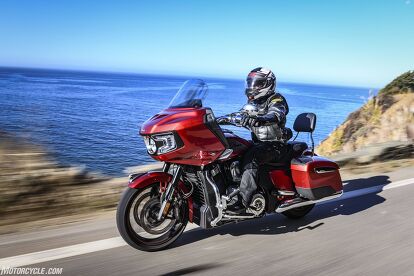










































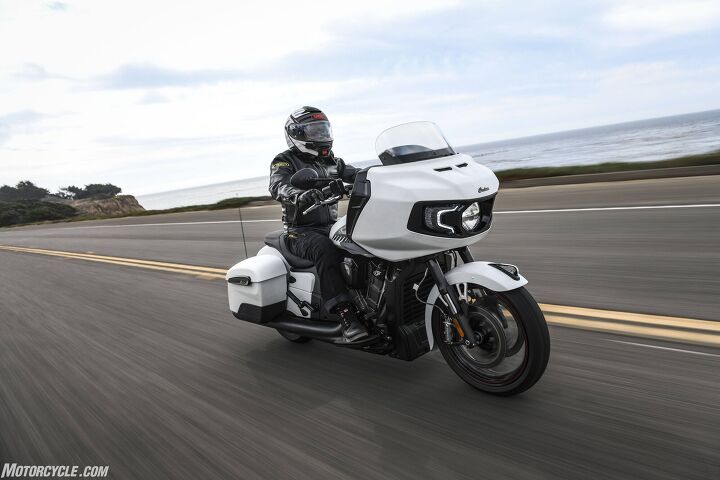














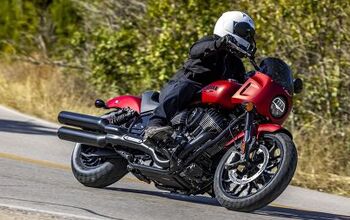
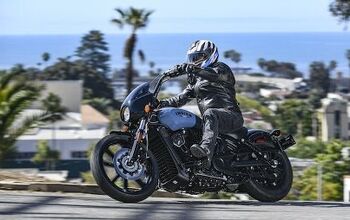







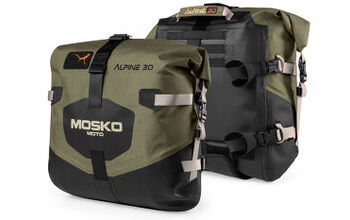






Comments
Join the conversation
Imagine how well it would handle if they knocked off a hundred or a hundred fifty pounds. For nearly 25g you’d think you could get some titanium, carbon fiber and magnesium parts to lighten them up a bit.
I test rode a Cheiftain last year and the entire time I kept thinking “why are these levers and shifter and everything so effing big”!?!?
Am I the only one thinking that these baggers would be a lot more fun to ride if they were lighter and (dare I say) sportier?
Where is Harley's answer?